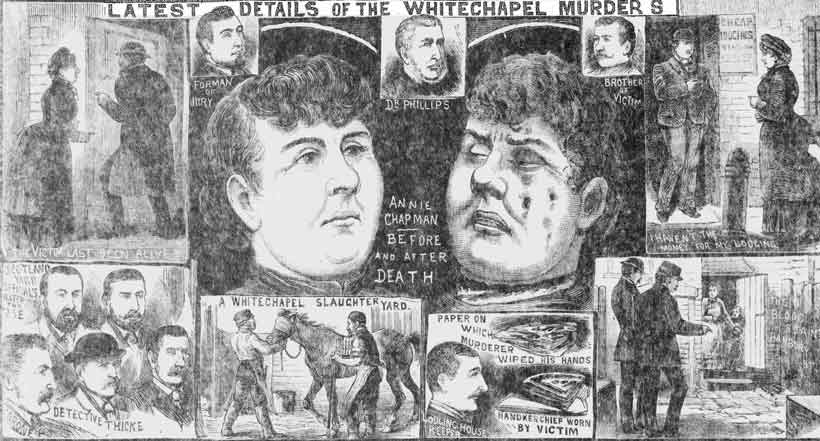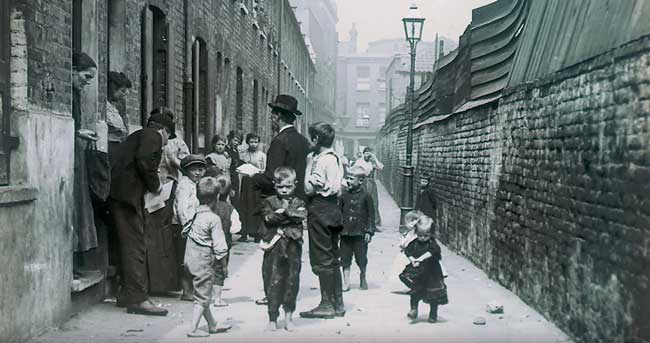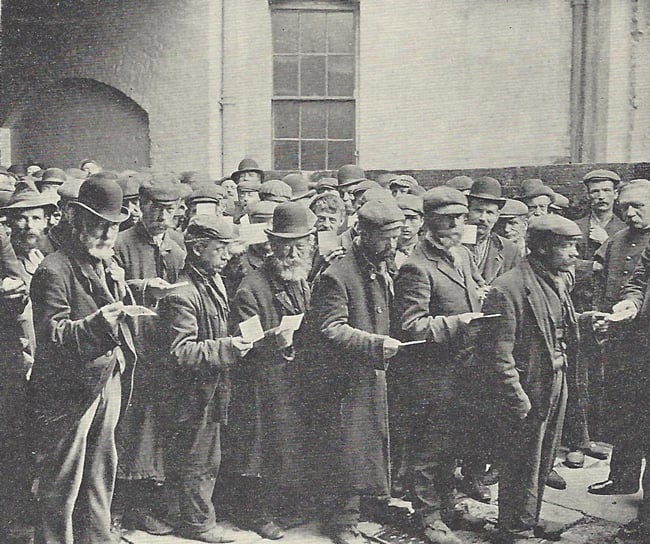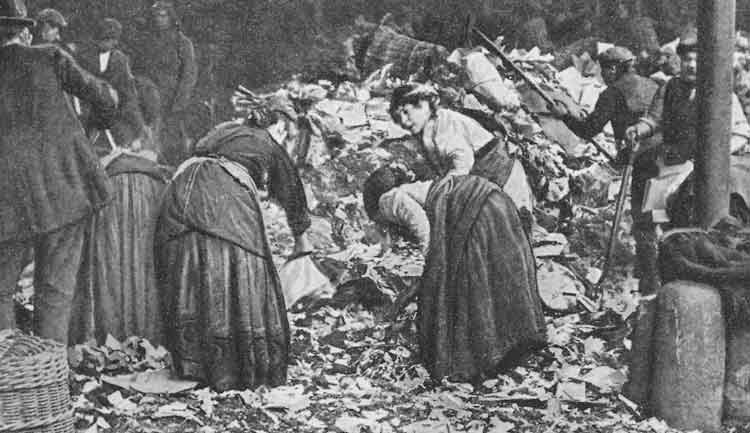One thing is certain about the Whitechapel Murders; they alerted society at large to the horrendous social conditions that had been allowed to develop, relatively unchecked, across the eastern fringe of the World’s wealthiest one square mile – the City of London.
Charles Dickens (1812 – 1870) and Henry Mayhew (1812 – 1887) had reported extensively on the everyday lives of the poor of the East End of the Victorian Metropolis. Philanthropists and social reformers had, for several decades, been warning of the dangers of allowing a vast underclass to wallow in poverty and depravity in and around the streets of Whitechapel and Spitalfields.
Yet, society at large had largely ignored their warnings; largely on account of the fact that few of the wealthier inhabitants of 19th century London would ever cross paths with their downtrodden compatriots.
THE NEMESIS OF NEGLECT
Jack the Ripper, with his series of gruesome murders, proved the ideal villain on which to hang East End ills in general; and, very soon into his reign of terror, those who had been lecturing society on the necessity for change, had succeeded in linking the Whitechapel murders with the sordid state of the East End in the eyes of society at large.
In other words, Jack the Ripper had succeeded in doing what social reformers and agitators had been trying to do – and largely failing to do – for many years, make people take notice of the underclass that had grown up in the East End of London.
This was a point that George Bernard Shaw made in his famous letter “Blood Money to Whitechapel“; and it was this exposing of the horrendous social conditions that inspired one of the most memorable images of the Jack the Ripper saga, Punch’s cartoon, The Nemesis of Neglect.

THE AFTERMATH OF ANNIE CHAPMAN’S MURDER
In the immediate aftermath of the murder of Annie Chapman, which took place in Hanbury Street on the 8th of September 1888, newspapers were almost tripping over themselves to decry the sordid social conditions in the area that were being described in vivid detail at the inquest into her death – and in the other inquests into the deaths of Martha Tabram and Mary Nichols – and numerous articles were appearing in the daily papers that were, effectively, portraying Annie Chapman as a martyr to the social depravity of the East End of London.

THE VEIL DRAWN ASIDE
One such article appeared in The Morning Post on Wednesday the 12th of September 1888.
It read:-
“There is an aspect of the Whiteehapel tragedies which, though only of the nature of a side light, ought not to be disregarded.
We may call it the domestic aspect.
The veil has been drawn aside that covered up the hideous condition in which thousands, tens of thousands, of our fellow creatures live, in this boasted nineteenth century, and in the very heart of the wealthiest, the healthiest, the most civilised city in the world.
DEPLORABLE MISERY
We have all known for many years that deplorable misery, gross crime, and unspeakable vice – mixed and matted together – lie just off the main roads that lead through the industrial quarters of the Metropolis.
The daily sins, the nightly agonies, the hourly sorrows that haunt and poison and corrupt the ill-fated tenants and sojourners in these homes of degradation and disease have been again and again described with more or less truth and force by our popular writers; but it is when some crime or accident, more than usually horrible, has given vividness and reality to the previously unrealised picture, that we are brought to feel – what our keenest powers failed adequately to conceive before – how parts of our great capital are honeycombed with cells, hidden from the light of day, where men are brutalized, women are demonised, and children are brought into the world only to be inoculated with corruption, reared, in terror, and trained in sin, till punishment and shame overtake them too, and thrust them down to the black depths where their parents lie already lost, or dead to every hope or chance of moral recovery and social rescue.

THE SHORTCOMINGS OF SOCIETY
DICKENS and the Brothers MAYHEW have told us how such as these live, sin, suffer, and die. The clergy, painfully familiar with all of it, appeal for sympathy and help. Doctors know well the back scenes and sore sorrows of these squalid quarters, and are united in their testimony to the shortcomings of society which make such revolting conditions of life possible.
Here and there some well-born lady, with money and time at her command, forsakes for a few hours the refinements and amenities of her well-ordered home to do angel’s work in these degraded regions of festering filth, crouching crime, and moral blight.
And what such gracious visitors tell us is that “things could not be worse than they are,” but they cannot go into details where the facts are so hideous and unmentionable.
Then comes a terrible crime, bringing a revelation that fills every soul with horror, and makes us ask why sleeps the thunder, and how these things can be?
The answer is in the facts disclosed.
A WRETCHED BACKSTREET
Take the latest as a sample of the rest.
A wretched back street is crowded with houses of the most miserable class. Nearly all of them are let out in lodgings, of a single room, or part of a room.
The house where the murder was committed had no less than six families, all toilers for daily bread, some of questionable honesty or sobriety, and all, we may be sure, contaminated in greater or less degree by the vicious surroundings of their distressful home.
Some work at the markets, some at the docks, one is a carman, another a cooper, some of no occupation.
Loose women have as free run in these abodes as rabbits in a warren.
There is a continual coming and going.
Some go to work as early as one o’clock in the morning, others as late as four, or five, or six, so that the place is open all night and any one can get in, sometimes men and women in pairs, sometimes singly.
Precepts of decency are not observed, the standard of propriety is low, the whole moral atmosphere is pestilential.
Poverty in its direst forms haunts some dwellings, ghastly profligacy defiles others, and this in street after street, alley after alley, cul de sac after cul de sac, garret after garret, and cellar after cellar.

HOW CAN GOOD PREVAIL?
Amidst such gross surroundings who can be good? With this atrocious miasma continually brooding over them and settling down among them, who can rise to anything better?
Morally these people are not only lost – they are dead and buried.
What ministering angels can make their dry bones live and quicken them to a purer and happier life?
This is the part of the subject that clamours for immediate consideration, these are miseries that need immediate remedy, these are the lamentable conditions of human existence, which may well tax the wisest counsels and the most philanthropic consideration of the best men and women of the day.
Side by side with all the luxury, the ease, the magnificence, and abounding plenty of our vast Metropolis, are all these pitiable ground-down people bowed with misery, and steeped in crime.

FAR OFF STARS IN DARKEST NIGHTS
Happily there are here and there, like far off stars in darkest nights, exceptional instances of honesty, virtue, truth, and good human love, which to a small extent redeem the blackness of these moral wastes.
“Amid the strife of powers untrained within,
And hard external pressure which the mind
Lacks principle and courage to withstand
What beautiful and holy things there are!”
Let all allowance be made, in the estimate, for these; but of the rest what can be said? What can be done? How shall the help, the sympathy, the succour of the better circumstanced, the wealthy, and the well-to-do, be brought to bear with sweet reclaiming power among these lost ones?
It is not so much the truncheon of the policemen that is wanted as the wand, magical in its power and healing in its touch, of higher moral ministries – some centres at intervals in their very midst where the gentle ministrations of Christian love shall never be sought by the weary and heavy laden in vain, where the veriest outcast may knock and feel that there at least there are pitying hearts and open hands, the instruments of GOD in the recovery of man.
SADDENING SIGHTS OF MISERY
We take into the reckoning all that is being nobly done for the wretched people, but what we want to urge is that it is not half enough.
The saddening sight of pent-up misery which the recent four murders disclose confirm our complaint, that the better off classes have not yet risen to the height of self-denial and charity which the hardness of the lot of these close-packed, hard-working, much-suffering poor require to enable them to break through the fetters that bind them down and gall their necks till they are fain to let things drift, while they, like LAZARUS in his grave, are without the wish or power to rise to anything better.

CONDITIONS MUST IMPROVE
We do not forget how much of the difficulty of helping these people lies in the badness of their homes, the want of space, of better sanitation, and greater protection for the girls and children.
Political economy, too, has its voice in the problem. To improve wages on the one hand, and cheapen food on the other, is a great part of the task to be done; but the difficulty is how to meet exceptional cases by economic laws – in other words, variable demands by invariable rules of supply.
It is a melancholy truth that if the well-to-do classes were to empty all their pockets and coffers, and place the contents at the service of the numberless creatures of penury and want whose lot it is so painful to see and so hard to help, the evil would not be cured.
The laws of production would be interfered with, and the boundless sacrifice, however nobly meant, would defeat its own end.

IT WILL TAKE TIME
We fear we must take it as a fixed condition of the problem before us that whatever is done requires time.
To transmute the misery of our working poor into the plenteous comfort of fruitful industry requires the combination of many separate forces which can move successfully only within the area of economic laws; and these of necessity move but slowly.
But the pressing question is how these forces may be best combined and set in motion: and in the meantime how can the prompt and good offices of true benevolence intervene to help the evils that cannot wait.”
